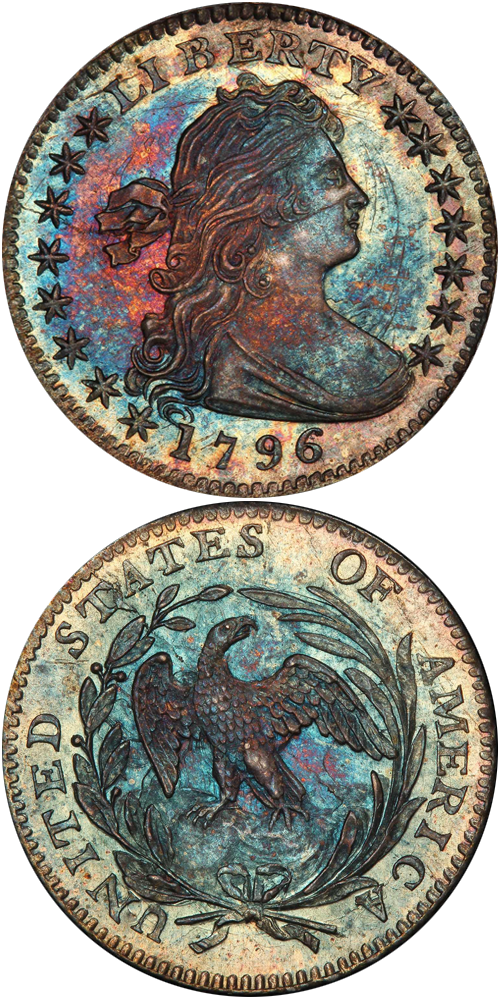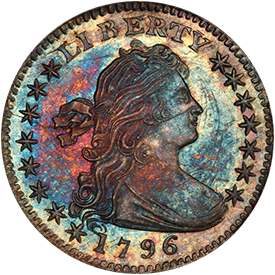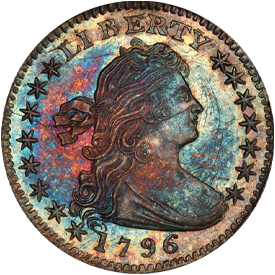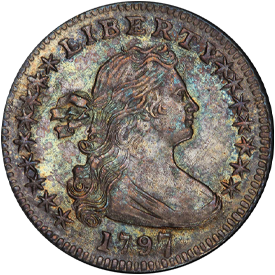Designed by: Robert Scot
Issue Dates: 1796-1797
Composition: 89.24% silver, 10.76% copper
Diameter: 16.5 mm
Weight: 1.34 grams (20.8 grains)
Edge: Reeded
Business Strike Mintage: 54,757
Proof Mintage: None
The Draped Bust style is believed to have been the work of Robert Scot, who followed the proposal made by artist Gilbert Stuart. The obverse depicts Miss Liberty with flowing hair, a ribbon behind her head, with drapery covering her plunging neckline. LIBERTY is above and the date is below. 1796 half dimes have eight stars to the left and seven to the right on the obverse, while those dated 1797 come in three variations, with a total of 13, 15, or 16 stars. The reverse features an open wreath enclosing a small eagle perched on a cloud, the eagle being smaller in size than that used in 1794-1795, and with the cloud more pronounced and higher above the wreath bow. UNITED STATES OF AMERICA surrounds. Again, there is no indication of value or denomination.
All half dimes of this design type are scarce. Most often encountered are lower grades from About Good through Fine. Very Fine pieces are elusive, Extremely Fine coins are rare and pieces in AU or better preservation are seldom met with. In the 1960s, when James F. Ruddy was gathering photographs for his Photograde book, he found that examples of this half dime type were among the most difficult to locate. As is true of other early silver coins, pieces are apt to have mint-caused adjustment marks and to be weakly struck in certain areas, particularly at the center of the eagle on the reverse.
Further Reading
In 1796 the half dime design was changed to the Draped Bust obverse with Small Eagle reverse. Although the eagle is small on this as well as the 1794-1795 type, it is differently styled on the later issues. On half dimes of 1796-1797 the eagle appears more substantial; less delicate.
The obverse portrays Miss Liberty with a draped bosom facing right, with stars and inscription somewhat similar to the earlier issues. It was at first proposed that 13 stars be used as a standard for American coinage, but as additional states joined the Union, more stars were added. Thus in 1797, half dimes with 15 stars on the obverse and, finally, 16 stars were created. At that point it was realized that the star increments had seemingly unlimited potential, and soon there would be no room left on the front of the coin for anything else! So, the 13-star format was reverted to in later years.
The first issue among 1796-1797 half dimes is an overdate, 1796/5. This indicates that a Draped Bust coinage of 1795 was contemplated, but such coinage never materialized, and "1795 Draped Bust" half dimes exist only in overdate form.
Another variety of the 1796 half dime is the so-called LIKERTY issue. This is really not deserving of being called a separate variety, although tradition has dictated listing it as such in reference books. What appears to be an erroneous K is not a K at all but is simply a B which was originally perfect in the die but, which over a period of time, became worn at the top so that part is no longer visible. Don Taxay, in his Comprehensive Encyclopedia of United States Coins (published in 1971 and 1976), stated the situation perfectly when he noted that the coin is collected "due to the mistaken notion that it is a blundered die."
The 1797 half dimes comprise three different varieties – with 13, 15, and 16 stars on the obverse. These intentional star varieties are in contrast with engraving errors, daydreaming, or whatever caused such unexplained anomalies as the 1817 large cent with 15 stars, the 1828 half cent with 12 stars, and the 1832 $5 with 12 stars.
High-grade half dimes of the 1796-1797 type are extremely rare. When collecting photographs for his Photograde grading book, James F. Ruddy found that well preserved examples of this issue were harder to find than were any other major United States coin types, including designs that were much higher-priced. It is very often the case that catalogue values have little to do with rarity or, for that matter, the frequency of appearance of pieces on the market.
In the 1970s, when David Akers published a series of six volumes covering the frequency of auction appearances of various gold coins from dollars through double eagles, his findings upset a number of traditions. Certain coins long considered to be rarities seemed to be plentiful, and numerous "common" pieces were so elusive that examples in certain grades had not crossed the auction block in years. This sort of circumstance contributes to the thrill of the chase. If everything about United States coins were known to the last decimal point there would be nothing left for the imagination, no new discoveries, no room for individuality, no opportunity for research, no chance to acquire sleepers or bargains. As it is, the numismatist who takes time to study coins can find many unappreciated items available for reasonable prices, just financial reward for the efforts expended in seeking them out.
It should be noted however that over the past 35 years or so, the PCGS and NGC Population Reports have painted a much clearer picture of the rarity of all issues in various grades, and those statistics serve as the current benchmark for rarity in today’s numismatic marketplace.
In worn grades half dimes of the 1796-1797 years are scarce. The 1796/5 overdate is a rarity in all conditions, but it only lists for a small premium over others of its design. In Uncirculated condition the issue most often seen is the normal (not overdate) 1796. This seems to be several times more plentiful than 1797. In addition to displaying adjustment marks, which are often seen, half dimes of 1797 tend to be weakly defined on the reverse, with the eagle sometimes appearing simply as an outline, without detailed feathers. Like half cents, large cents, and other issues of this era, these early half dimes have personalities. Not only is each die variety different, each coin encountered seems to be different from the one before or after it. Such adds the undefinable quality which Dr. Sheldon characterized as “charm.”









